Bert's Town - Part 03 - A Choice Of Routes
w/e 26 April 2009
All this week's pictures were taken
with a Kodak DX6490

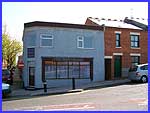 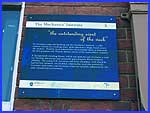 As
we approach the top of Mansfield Road the reminders of D H Lawrence
and his connections with Eastwood come thick and fast. The property
at the junction with Princes Street has been restored to look
as it did when Bert lived here and now trades as the Lawrence
Snackery (left) whilst on another building a little further up
the hill is the third blue information board (right) on the Blue
Line Trail. As
we approach the top of Mansfield Road the reminders of D H Lawrence
and his connections with Eastwood come thick and fast. The property
at the junction with Princes Street has been restored to look
as it did when Bert lived here and now trades as the Lawrence
Snackery (left) whilst on another building a little further up
the hill is the third blue information board (right) on the Blue
Line Trail.
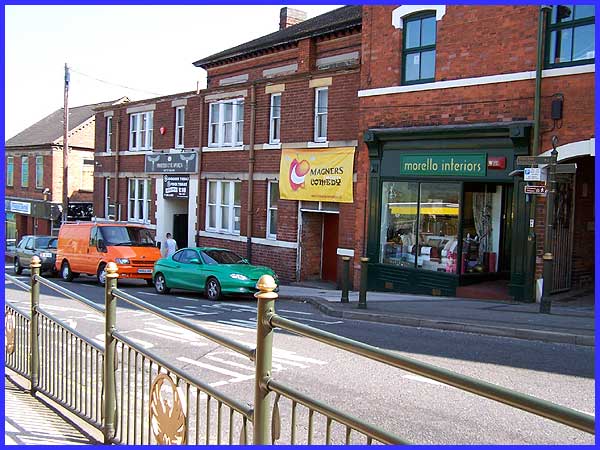
The building in question is the former Mechanics' Institute and
the blue board which is just visible in the image above directly
above the orange van tells us that the Institute was a nineteenth
century version of a working mans' adult education college. Institutes
such as this were often funded by wealthy industrialists and
local colliery owner Thomas Barber was the first president of
this one in Eastwood. The Institute also housed a lending library
that was open for just two hours each week on a Thursday and
both Bert Lawrence when in his mid teens and a young Jessie Chambers
with whom he had his first romantic relationship used the collection
of some 1500 books extensively. The information board concludes
"his future work was certainly influenced by this early
introduction to literature."
Lawrence was born on 11th September 1885 and had a number of
poems published in 1909 by Ford Madox Ford in 'English Review'
after they had been submitted by Jessie Chambers. Four years
later his now famous novel 'Sons and Lovers' was published but
this was after it had been rejected by Heinemann. The rejection
caused him to write to a friend "Curse the blasted, jelly-boned
swines, the slimy, the belly-wriggling invertebrates, the miserable
sodding rutters, the flaming sods, the snivelling, dribbling,
dithering, palsied, pulse-less lot that make up England today"
which makes one wonder whether this outburst was as a result
of his studies of the books in the library or whether it was
as a result of hearing this language among the working class
miners in Eastwood.
'Sons and Lovers' of course was based on his childhood and the
character of Miriam in the novel owes a lot to his sweetheart
Jessie. The second plaque on the Literary Trail is embedded into
the footpath outside the Institute and carries the following
quotation from the novel: "The library was open in two
rooms in the Mechanics Hall, on Thursday evenings from 7 till
9. Paul always fetched the books for his mother, who read a considerable
amount, and Miriam trudged down with five or six volumes for
her family. It became a custom for the two to meet in the library."
|
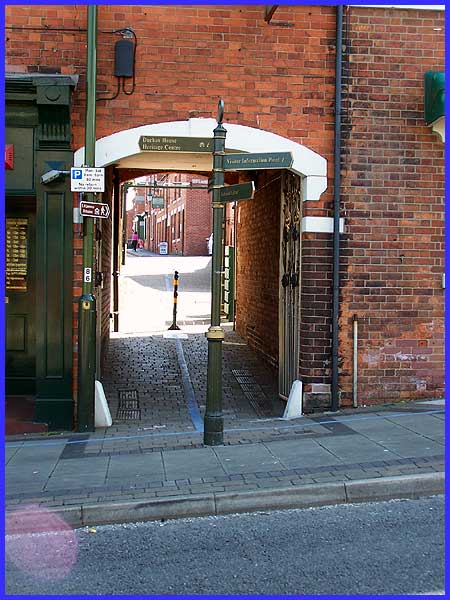
Just a few steps from the Mechanics' Institute the Blue Line
Trail splits and offers a choice of route. Passing through the
archway leads directly to the D H Lawrence Birthplace Museum
in less than a hundred yards (or metres if you prefer). The gate
at the arch is sometimes locked so the alternative route is to
carry on up Mansfield Road, left into Nottingham Road and left
again to access the museum on Victoria Street.
|
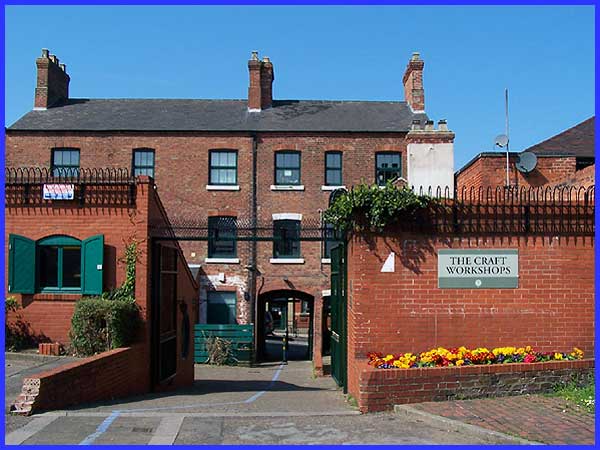
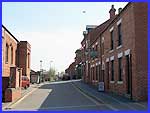 Adjacent to the museum are a number
of Craft Workshops (left and above). In this complex of working
studios, mainly housed in the old refurbished cottages on Scargill
Walk it is possible to watch craftsmen and women at work with
many of the efforts of their toils available to purchase as souvenirs.
Both the Birthplace Museum (which we shall see in a later part
in this series) and the Craft Workshops can be also be accessed
by either route but as we are also combining the Blue Line Trail
with the Literary Trail we shall return through the archway to
continue up Mansfield Road. Adjacent to the museum are a number
of Craft Workshops (left and above). In this complex of working
studios, mainly housed in the old refurbished cottages on Scargill
Walk it is possible to watch craftsmen and women at work with
many of the efforts of their toils available to purchase as souvenirs.
Both the Birthplace Museum (which we shall see in a later part
in this series) and the Craft Workshops can be also be accessed
by either route but as we are also combining the Blue Line Trail
with the Literary Trail we shall return through the archway to
continue up Mansfield Road.
|
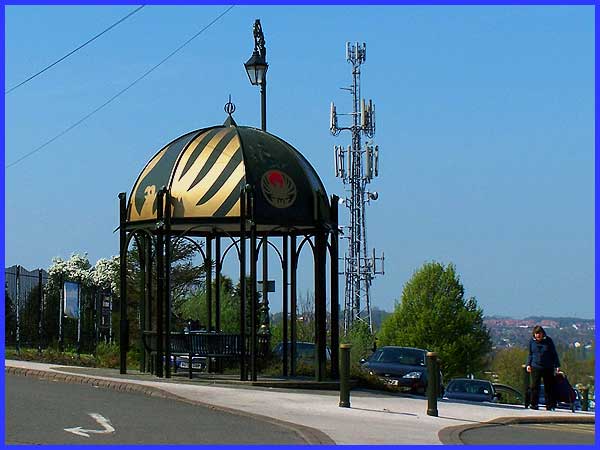
On regaining Mansfield Road the most prominent feature opposite
(if you can ignore the telecommunications mast) is the seating
area in the middle of a car parking area. I am led to understand
that this is the D H Lawrence Memorial and I think at one time
an information board was attached to the structure. At present
though no such board is apparent but the phoenix symbol on the
domed roof of the seat suggests the connection to the author
who of course adopted the phoenix as his personal symbol. In
fact the symbol can be seen all around the town and even the
safety railings at the edge of the footpaths have the symbol
incorporated into their design.
|
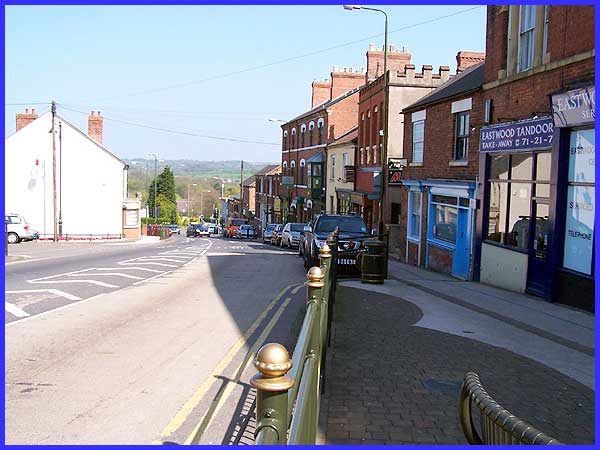
Some of those railings can be seen in this view towards Brinsley
back down Mansfield Road from its junction with Nottingham Road.
The edge of another seat can also be seen in the bottom right
hand corner of the picture and if you look closely you will also
be able to see the third of those literary plaques among the
cobbles. This one contains another quotation from 'Sons and Lovers':
"They came near to the colliery. It stood quite still
and black among the corn-fields, its immense heap of slag seen
rising almost from the oats. What a pity there is a coal-pit
here where it is so pretty," said Clara. "Do you think
so?" he answered. "You see, I am so used to it, I should
miss it." Clara's companion would no doubt be missing
it today for coal-pits in the area have long gone.
|

We make a brief foray off the Blue Line Trail here to cross Mansfield
Road to see the fourth plaque on the Literary Trail outside the
Sun Inn where an information board on the wall of the inn details
a five mile circular walk to Brinsley and back plus another that
proclaims the inn was the birthplace of the Midland Railway in
1832. This literary plaque has another quotation from 'Sons and
Lovers' that reads: "Mrs Morel loved her marketing. In
the tiny market-place on the top of the hill, where four roads,
from Nottingham and Derby, Ilkeston and Mansfield meet, many
stalls were erected."
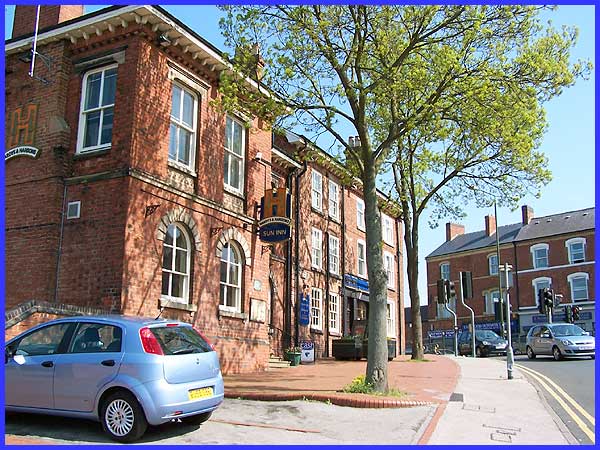
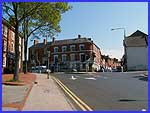 The market stalls
that Mrs Morel loved stood in front of the Sun Inn but road widening
and the introduction of a one way system (left) around the inn
mean that any market trader would be quite foolhardy to attempt
any business here today especially with the volume of traffic
that passes. The Sun Inn dates back to 1750 and has several claims
to fame. Besides that meeting The market stalls
that Mrs Morel loved stood in front of the Sun Inn but road widening
and the introduction of a one way system (left) around the inn
mean that any market trader would be quite foolhardy to attempt
any business here today especially with the volume of traffic
that passes. The Sun Inn dates back to 1750 and has several claims
to fame. Besides that meeting 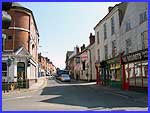 in 1832 when local colliery owners agreed
to contribute £32,000 towards the development of a railway,
it was also prominent as a watering hole for workers marching
to Nottingham in 1817 during the 'Pentrich Revolution'. Maybe
not quite so noteworthy but not surprisingly it was also one
of the haunts of Bert's father, a heavy drinker who often crossed
its threshold. Crossing back over Mansfield Road we now rejoin
the Blue Line Trail to continue into Nottingham Road (right). in 1832 when local colliery owners agreed
to contribute £32,000 towards the development of a railway,
it was also prominent as a watering hole for workers marching
to Nottingham in 1817 during the 'Pentrich Revolution'. Maybe
not quite so noteworthy but not surprisingly it was also one
of the haunts of Bert's father, a heavy drinker who often crossed
its threshold. Crossing back over Mansfield Road we now rejoin
the Blue Line Trail to continue into Nottingham Road (right).
|

